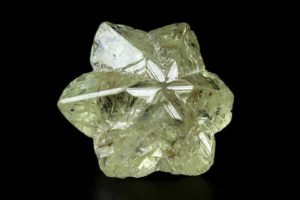
The mineral or gemstone chrysoberyl is a beryllium aluminate with the formula BeAl2O4. The name chrysoberyl is derived from the Greekwords χρυσός chrysos and βήρυλλος beryllos, meaning “a gold-white spar”. Despite the similarity of their names, chrysoberyl and beryl are two entirely different gemstones, although they both contain beryllium. Chrysoberyl is the third hardest commonly encountered natural gemstone and lies at 8.5 on the Mohs scale of mineral hardness, between corundum (9) and topaz (8).
The ordinary chrysoberyl is yellowish-green and transparent to translucent. When the mineral has a good pale green to yellow colour and is transparent, it is used as a gemstone. The three main varieties of chrysoberyl are: ordinary yellow-green chrysoberyl, cat’s eye or cymophane, and alexandrite. Yellow-green chrysoberyl was referred to as “chrysolite” during the Victorian and Edwardian eras, which caused confusion since that name was also used for mineral olivine (‘peridot’ as a gemstone); this name is no longer used in the gemological nomenclature.
Chrysoberyl Occurrence
Chrysoberyl forms as a result of pegmatic processes. Melting in Earth’s crust produces relatively low-density molten magma, which can rise up to the surface. As the main magma body cools, the water initially present at low concentrations became more concentrated in the molten rock because it could not be incorporated into the crystallisation of solid minerals. The remaining magma thus becomes richer in water, and also in rare elements that similarly do not fit into the crystal structures of the major rock-forming minerals. Water extends the temperature range downwards before the magma becomes completely solid, allowing the concentration of rare elements to proceed to the point where they produce their own distinctive minerals. The resulting rock is igneous in appearance but formed at a low temperature by a water-rich melt, with large crystals of common minerals such as quartz and feldspar, but also with elevated concentrations of rare elements such as beryllium, lithium or niobium, often forming their own minerals; this is called pegmatite. The high water content of the magma made it possible for the crystals to grow rapidly, so that the pegmatite crystals are often quite large, increasing the likelihood of gems forming.
Chrysoberyl may also grow in country rocks near pegmatites, when pegmatite-rich be-and al-rich fluids react with surrounding minerals. It can therefore be found in mica shales and in contact with the metamorphic deposits of dolomitic marble. Because it is a hard , dense mineral that is resistant to chemical alteration, it can be wetted out of rocks and deposited in river sands and gravels in alluvial deposits with other gem minerals such as diamonds, corundum, topaz, spinel, granite and tourmaline. When found in such pleasures, there will be rounded edges instead of sharp, wedge-shaped shapes. Much of the chrysoberyl mined in Brazil and Sri Lanka is recovered from pleasure, as the host rocks have been severely weathered and eroded.
If the pegmatite fluid is rich in beryllium, beryllium or chrysoberyl crystals may form. Beryl has a high ratio of beryllium to aluminium, while the opposite is true of chrysoberyl. Both are stable with a common quartz mineral. Some chromium would also have had to be present to form alexandrite. However, beryllium and chromium do not tend to occur in the same rock types. Chromium is most common in mafic and ultramafic rocks where beryllium is extremely rare. Beryllium is concentrated in felsic pegmatites where chromium is almost absent. Therefore, the only situation where alexandrite can grow is when Be-rich pegmatite fluids react with Cr-rich country rock. This unusual requirement explains the rareness of this chrysoberyl variety.
Physical Properties of Chrysoberyl
Cleavage: {110} Distinct, {010} Imperfect, {???} Imperfect
Color: Blue green, Brown, Brownish green, Green, Gray.
Density: 3.5 – 3.84, Average = 3.67
Diaphaneity: Transparent to translucent
Fracture: Brittle – Generally displayed by glasses and most non-metallic minerals.
Habit: Prismatic – Crystals Shaped like Slender Prisms (e.g. tourmaline).
Habit: Tabular – Form dimensions are thin in one direction.
Habit: Twinning Common – Crystals are usually twinned.
Hardness: 8.5 – Chrysoberyl
Luminescence: Non-fluorescent.
Luster: Vitreous (Glassy)
Streak: white
What is chrysoberyl used for?
Chrysoberyl is not present in large deposits to be used as a beryllium ore. Its only used as a gemstone due to its very high hardness and its unique properties.
How much is chrysoberyl worth?
Chrysoberyl has recently been marketed for tens of thousands of dollars, with alexandrite chrysoberyl often hitting over $100,000.
Related Article: Top 10 World’s Rarest & Valuable Gems










